Quando cerchiamo di accedere ai nostri siti web WordPress, a volte la pagina di login si aggiorna e si reindirizza continuamente, impedendoci di accedere all’area di amministrazione di WordPress.
Se state sperimentando questo problema, non siete i soli. Il problema dell’aggiornamento e del reindirizzamento della pagina di login di WordPress è comune e frustra molti proprietari di siti WordPress. Detto questo, abbiamo testato diversi metodi collaudati per risolvere il problema.
In questa guida completa, vi mostreremo come risolvere il problema del refresh e del reindirizzamento della pagina di login di WordPress. Immergiamoci e torniamo alla dashboard di WordPress per riprendere il controllo del vostro sito web!
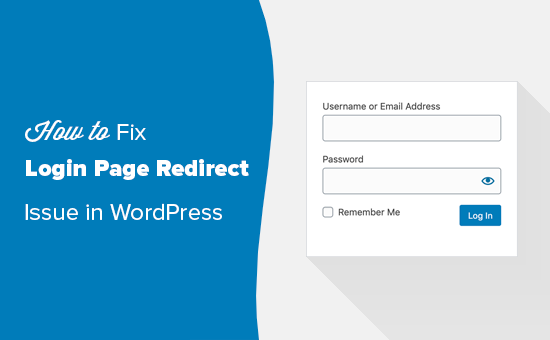
Cosa causa il problema di aggiornamento e reindirizzamento della pagina di login in WordPress?
L’errore di aggiornamento e reindirizzamento della pagina di login di WordPress (chiamato anche loop di reindirizzamento del login di WordPress) è solitamente causato da impostazioni errate dell’URL di WordPress o dalla mancata impostazione dei cookie di login.
Normalmente, quando si accede, WordPress convalida il nome utente e la password e poi imposta un cookie di accesso nel browser. Successivamente, l’utente viene reindirizzato alla dashboard di WordPress.
Se WordPress non riesce a impostare correttamente il cookie di accesso o l’URL dell’area di amministrazione di WordPress non è corretto, si verrà reindirizzati alla schermata di accesso anziché alla dashboard di amministrazione.
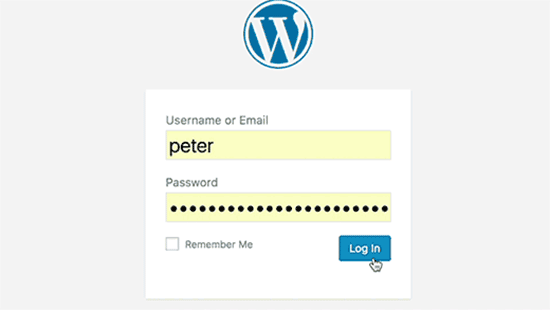
I problemi di accesso possono essere causati anche da diversi errori di WordPress, come l’errore di connessione al database, l’errore interno del server o la schermata bianca della morte.
Con queste premesse, cerchiamo di risolvere il problema del reindirizzamento e dell’aggiornamento della pagina di login di WordPress. Potete utilizzare questi collegamenti rapidi per passare a un metodo specifico:
- Method 1: Clear Cookies to Resolve Login Issues
- Method 2: Update WordPress URL Settings
- Method 3: Delete .htaccess File in WordPress
- Method 4: Deactivate Your Plugins
- Method 5: Revert Back to the Default Theme
- Method 6: Reinstall WordPress Core
- Video Tutorial
- What to Do If You Can't Fix WordPress Login Redirect Issue
Nota: se volete provare i passaggi avanzati di questo tutorial su WordPress, create prima un backup del vostro sito. Consultate la nostra guida su come creare manualmente un backup del database di WordPress.
Metodo 1: Cancellare i cookie per risolvere i problemi di accesso
WordPress utilizza i cookie per l’autenticazione del login, quindi il primo passo per risolvere i problemi di login di WordPress è il più semplice. È necessario cancellare i cookie e la cache del browser.
In Google Chrome, è sufficiente fare clic sul menu delle impostazioni del browser e poi selezionare Altri strumenti ” Cancella dati di navigazione.
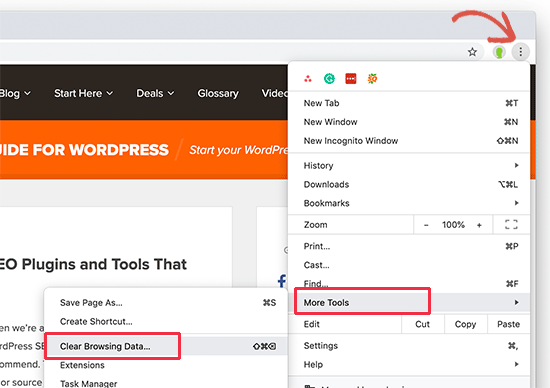
Si aprirà la pagina delle impostazioni di Chrome con un popup “Cancella dati di navigazione” visualizzato sullo schermo.
Da qui è necessario selezionare le opzioni “Cancella cookie e altri dati del sito” e “Immagini e file nella cache”.
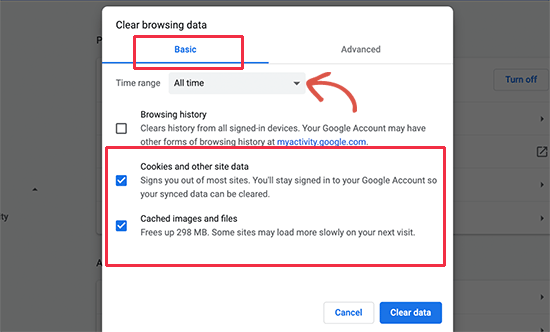
Quindi, fate clic sul pulsante “Cancella dati” e Google Chrome cancellerà la cache del browser.
Assicuratevi inoltre che il vostro browser abbia i cookie abilitati. Dopo aver fatto ciò, riavviare il browser e provare ad accedere. Questo dovrebbe risolvere il problema per la maggior parte delle persone.
Abbiamo una guida completa con schermate che mostrano come cancellare la cache e i cookie in tutti i principali browser.
Metodo 2: Aggiornare le impostazioni degli URL di WordPress
WordPress è dotato di impostazioni per l’URL del vostro sito web e per l’URL della vostra installazione di WordPress.
Se si ha accesso all’area di amministrazione di WordPress, si può vedere questa opzione nella pagina Impostazioni ” Generale”.
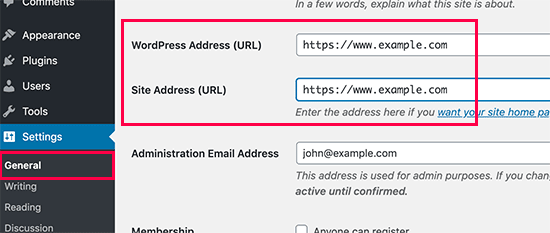
Se questi URL non sono corretti, WordPress vi reindirizzerà alla pagina di accesso.
Poiché non è possibile accedere all’area di amministrazione di WordPress, è necessario modificare il file wp-config.php per risolvere il problema.
Il file wp-config.php è un file speciale di WordPress che contiene le impostazioni importanti di WordPress. Potete accedervi utilizzando un client FTP o tramite l’applicazione File Manager nella dashboard del vostro account di hosting WordPress.
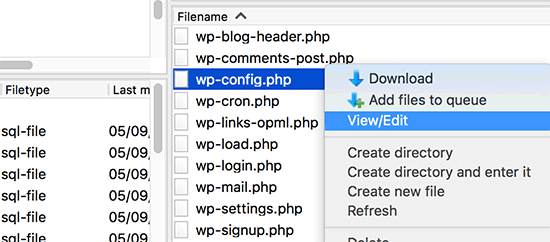
Il file wp-config.php si trova nella cartella principale del sito. Basta modificare il file e incollare le seguenti righe di codice appena prima di quella che dice: "È tutto, smettete di modificare! Buona pubblicazione".
define('WP_HOME','https://www.example.com');
define('WP_SITEURL','https://www.example.com');
Non dimenticate di sostituire “example.com” con il vostro nome di dominio.
Quindi, salvare le modifiche e caricare il file sul proprio sito web.
Ora potete visitare il vostro sito web WordPress e provare ad accedere. Si spera che questo abbia risolto il problema. Se così non fosse, continuate a leggere per ulteriori passaggi di risoluzione dei problemi.
Metodo 3: Eliminare il file .htaccess in WordPress
A volte, il file .htaccess può essere danneggiato, causando errori interni al server o l’errore di aggiornamento della pagina di login.
È sufficiente accedere al vostro sito web utilizzando un client FTP o tramite l’applicazione File Manager nella dashboard del vostro provider di hosting.
Una volta collegati, individuare il file .htaccess nella directory principale del sito web e scaricarlo sul computer come backup.
Se non riuscite a trovare il vostro file .htaccess, questa guida sul perché il vostro file .htaccess potrebbe essere mancante può aiutarvi.
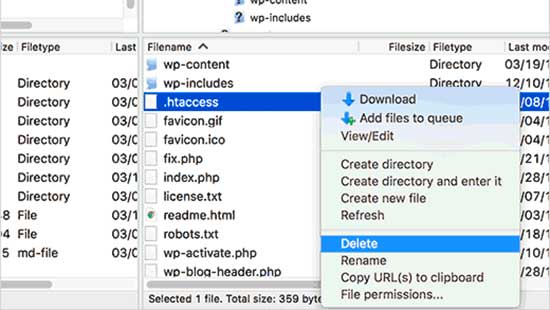
Dopodiché, cancellate il file .htaccess dal vostro sito web.
Quindi, aprire la cartella wp-admin e, se c’è un file .htaccess, cancellare anche quello.
Ora potete provare ad accedere al vostro sito web WordPress. Se ci riuscite, significa che il file .htaccess vi impediva di accedere a WordPress.
Una volta effettuato l’accesso, basta andare alla pagina Impostazioni ” Permalinks nel pannello di amministrazione di WordPress e fare clic sul pulsante “Salva” senza apportare alcuna modifica. In questo modo verrà generato un nuovo file .htaccess per il vostro sito web.
Metodo 4: Disattivare i plugin
A volte, i plugin di WordPress possono causare questo problema, soprattutto se c’è un conflitto tra due plugin.
Per disattivare facilmente tutti i plugin di WordPress, collegatevi al vostro sito web utilizzando un client FTP o tramite l’applicazione File Manager nella dashboard del vostro account di web hosting.
Una volta collegati, andate nella cartella /wp-content/. Al suo interno, vedrete una cartella denominata “plugins”. È qui che WordPress installa tutti i vostri plugin.
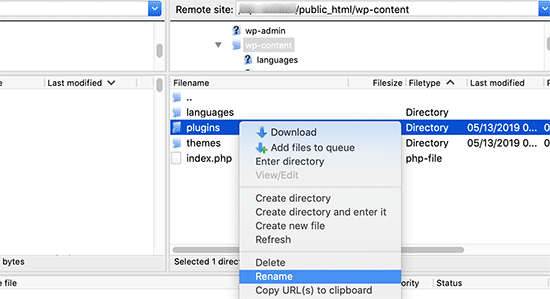
È sufficiente rinominare la cartella dei plugin in “plugins_backup”. In questo modo verranno disattivati tutti i plugin di WordPress installati sul vostro sito web.
Abbiamo anche un tutorial dettagliato su come disattivare tutti i plugin di WordPress quando l’amministrazione di WordPress è inaccessibile.
Una volta disattivati tutti i plugin, provate ad accedere al vostro sito WordPress. Se ci riuscite, significa che il problema era causato da uno dei vostri plugin.
Metodo 5: Tornare al tema predefinito
I temi di WordPress possono causare conflitti anche dopo l’aggiornamento a una versione più recente di WordPress o del tema stesso. Per scoprire se il problema è causato dal tema, è necessario disattivarlo.
Il processo è simile alla disattivazione dei plugin. Collegatevi al vostro sito web utilizzando un client FTP. Quindi, si deve andare nella directory /wp-content/themes/ e rinominare la directory del tema corrente in “themes_backup”.
Una volta fatto questo, provare ad accedere di nuovo. Se ci si riesce, significa che il problema era causato dal tema.
Ora è possibile reinstallare una nuova copia del tema per verificare se il problema si risolve. Se il problema si ripresenta, è necessario contattare l’assistenza del tema o passare a un tema WordPress diverso.
Metodo 6: Reinstallare il nucleo di WordPress
In rari casi, il problema della ricarica persistente della pagina di accesso potrebbe essere causato da file corrotti del nucleo di WordPress.
Questi file fondamentali sono la base del sito web WordPress e gestiscono le funzionalità essenziali. Se questi file si danneggiano o vengono sovrascritti con codice non corretto, possono verificarsi vari errori, tra cui problemi di accesso.
Innanzitutto, visitate WordPress.org e scaricate l’ultima versione del software. Una volta scaricato, decomprimere il file sul computer. Verrà creata una cartella denominata “wordpress” contenente tutti i file necessari per la reinstallazione.
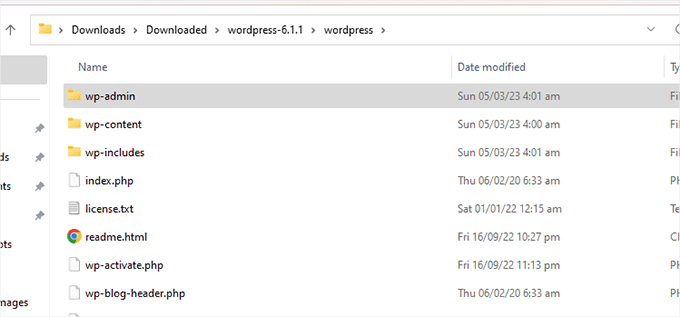
Successivamente, è necessario collegarsi al sito web utilizzando un client FTP o il file manager fornito dal fornitore di hosting.
Una volta collegati, navigare nella cartella principale del sito web. Si tratta della directory principale che contiene cartelle come wp-admin, wp-content e wp-includes.
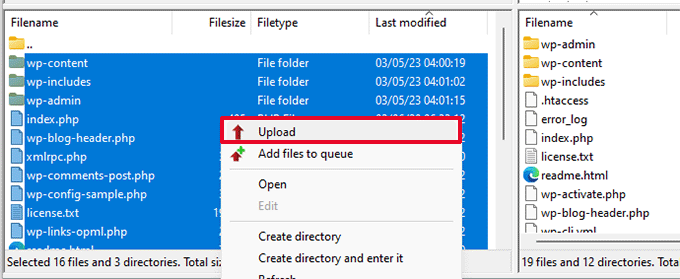
A questo punto, prendete tutti i file dalla cartella “wordpress” sul vostro computer e caricateli nella directory principale del vostro sito web.
Il client FTP chiederà di confermare la sovrascrittura di eventuali file di base esistenti.
Poiché state eliminando i file core di WordPress danneggiati e li state sostituendo con altri nuovi, scegliete “Sovrascrivi” e selezionate l’opzione “Usa sempre questa azione” per evitare di dover confermare ogni singolo file.
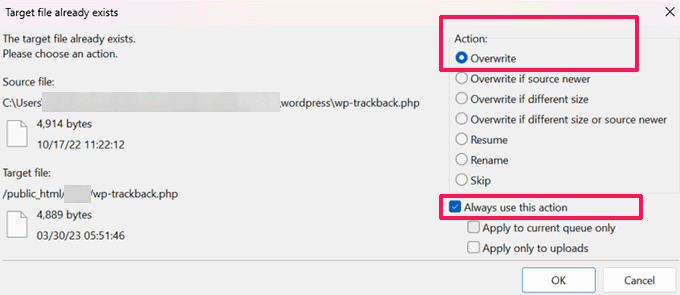
Infine, fate clic su “OK” per avviare il processo di uploader. Il vostro client FTP sostituirà i file principali di WordPress sul vostro sito web con quelli freschi del vostro computer.
Una volta completato l’uploader, visitate il sito web per vedere se l’errore è corretto. Se il problema di accesso è causato da un file core corrotto o da un malware, il messaggio di errore dovrebbe essere sparito e si dovrebbe poter accedere con successo.
Video tutorial
Se avete bisogno di istruzioni visive, guardate il video qui sotto.
Cosa fare se non si riesce a correggere il problema del reindirizzamento dell’accesso a WordPress
Se avete provato di tutto, dal cancellare i cookie del browser alla disattivazione di temi e plugin, ma il problema persiste, potete provare a chiedere supporto alla comunità di WordPress.
Gli utenti di gruppi come il gruppo Facebook di WPBeginner Engage potrebbero aver riscontrato il vostro stesso problema e potrebbero fornirvi indicazioni su cosa fare per risolvere i problemi della pagina di accesso.
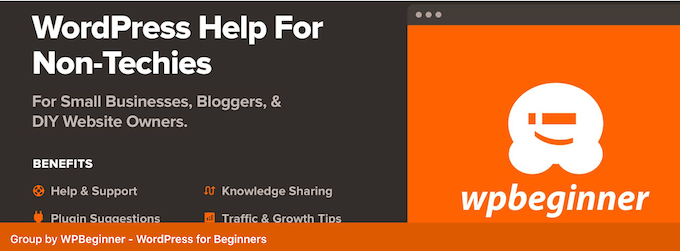
A parte questo, potete rivolgervi a soluzioni di assistenza WordPress come WPBeginner Pro Services. Offriamo un servizio di assistenza WordPress d’emergenza, in cui gli esperti possono individuare cosa sta succedendo al vostro sito web e risolvere il problema alla radice.
Potete anche assumere i nostri servizi di manutenzione di WordPress per evitare che problemi come malware, tempi di inattività elevati e WordPress obsoleto colpiscano il vostro sito web in primo luogo.
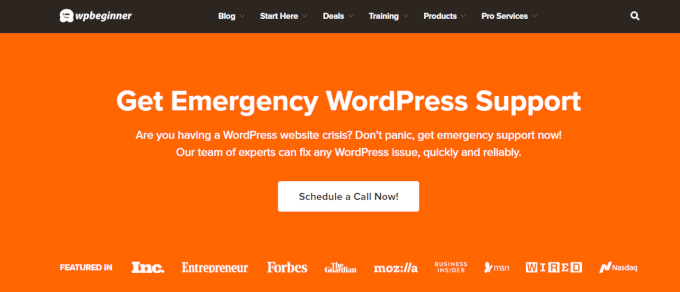
Non esitate a prenotare un appuntamento con il nostro team oggi stesso per vedere cosa possiamo fare per sistemare il vostro sito web.
Learn More WordPress Soluzioni per la risoluzione dei problemi
Avete riscontrato altri errori comuni di WordPress e avete bisogno di trovare un modo per correggerli? Ecco altri articoli che potete consultare:
- Come correggere l’errore Troppi reindirizzamenti in WordPress
- Come correggere facilmente l’errore “This Site Can’t Be Reached” in WordPress
- Come correggere il messaggio “Il sito sta riscontrando difficoltà tecniche” in WordPress
- Come correggere gli articoli di WordPress che ritornano con l’errore 404 (passo dopo passo)
- Come correggere l’errore di contenuto misto in WordPress (passo dopo passo)
- Come correggere l’errore JSON non valido in WordPress (guida per principianti)
- Come trovare e accedere ai registri degli errori di WordPress (passo dopo passo)
- Come correggere il problema del mancato invio di email da parte di WordPress
- Come correggere WordPress bloccato in modalità manutenzione (in modo semplice)
Speriamo che questo articolo vi abbia aiutato a risolvere il problema del refresh e del reindirizzamento della pagina di login di WordPress. Potreste anche voler consultare la nostra guida completa alla risoluzione dei problemi di WordPress o dare un’occhiata alla nostra classifica dei migliori plugin e strumenti di WordPress per far crescere il vostro sito.
Se questo articolo vi è piaciuto, iscrivetevi al nostro canale YouTube per le esercitazioni video su WordPress. Potete trovarci anche su Twitter e Facebook.





Amnon Jakony
Deleting htaccess file worked fine for me…
WPBeginner Support
Glad to hear it was able to help you!
Admin
Harry k
Thanks for this video and the post. I tried above all of your methods but none of them fixed the issue. read the comment and found a solution as below. Edit HTTPS to HTTP.
define(‘WP_HOME’,’https://example.com’);
define(‘WP_SITEURL’,’https://example.com’);
to
define(‘WP_HOME’,’http://example.com’);
define(‘WP_SITEURL’,’http://example.com’);
WPBeginner Support
The issue with this method would be that your site would start to show the not secure message as your site would not be using HTRTPS. This can be a temporary workaround but you would want to update your site to use HTTPS after you are able to log in.
Admin
Tobias
No luck none of them worked
WPBeginner Support
If none of the methods from this article are working for you, we would recommend reaching out to your hosting provider for them to check if there are any errors on their end.
Admin
Salah
Thanks a lot,
You saved my day,
I have changed the file wp-config.php as described in the tutorial and that worked for me.
My best regards.
WPBeginner Support
Glad to hear our guide was helpful!
Admin
Robert clancy
I messed around with the Update WordPress URL Settings
and that was a world of pain to correct as it took my whole site down. I had to correct it through changing the config settings using FTP.
WPBeginner Support
The settings are definitely powerful and can cause issues if you change them incorrectly. Glad you were able to fix the issue using FTP!
Admin
DK John
Your first method worked for me. Thank you for this magical guide
WPBeginner Support
Glad our guide was helpful!
Admin
David Kuteesa
Tried all and none worked. Here is what worked:
Went to wp-config.php and set define( ‘WP_DEBUG’, false); to define( ‘WP_DEBUG’, true );
Tried logging in again and got “usermeta table missing” error.
Thats when I realised I had a missing table. Got it from another installation and changed the table prefix to meet current db.
Worked immediately
WPBeginner Support
Thank you for sharing this, for most beginners we recommend reaching out to their hosting provider if our recommendations do not work as they can check for less beginner friendly errors.
Admin
Stian
Thank you – that tip about restoring the admin page by adding two lines of code in the config file seems to work nicely (still crossing fingers), but I have hope now, which I didn´t earlier.
WPBeginner Support
We hope it helps!
Admin
WPBeginner Support
Glad our guide could help and if you hadn’t set up SSL before changing to https that would definitely be the most likely cause.
Admin
branhampaul
Thank You, it worked.
I initially had the siteurl & wp address url changed to “https”, and this made me unable to log-in my dashboard. Maybe because I had not ssl at my host set-up.
Re-changing the “https” to “http” helped me log-in back.
Bryan Veloso
Everything didn’t work. But after downgrading my PHP from 7.4 to 7.2, I was able to login.
Kinda weird, now I’m using an older PHP version.
Did you encounter an issue similar to mine? I want to use the newer PHP version, but it doesn’t let me login in wp-admin.
WPBeginner Support
More than likely, you may have a plugin causing a conflict, you would want to start by following our troubleshooting guide below:
https://www.wpbeginner.com/beginners-guide/beginners-guide-to-troubleshooting-wordpress-errors-step-by-step/
Admin
Alisha
This issue has never happened to me before, but the 2nd / plugin option worked for me right away.
This website is a lifesaver! Thank you so much!
WPBeginner Support
Glad our guide was helpful
Admin
Øivind
Thank you! The wp-config.php-metod worked for me!
WPBeginner Support
Glad our recommendation was able to assist
Admin
Ruta
I tried some of these steps, but the problem turned out to be elsewhere: my site was setup as a ‘multisite’ but in wp-config file it said ‘subdomain_install’ as ‘false’, when I changed it to ‘true’, I could login to the site normally without redirects
WPBeginner Support
Glad you found the solution to the issue
Admin
Jerry
This was also my problem! I tried all the steps mentioned in the article, but after changing the ‘subdomain_install’ from false to true in the wp-config.php file it worked!!
Thanks!!
Joe
I have been trying to solve this for MONTHS… Thanks to your comment, I was able to fix it in about 10 seconds. Thank you so much for sharing!
This should be included in the tutorial.
Brayton Scott
Awesome, and simply tutorial. 1st suggestion fixed my site.
WPBeginner Support
Glad our recommendation could help
Admin
Fraser
I followed the instructions to deactivate all plugins and I now have access to wp-admin again! The instructions were easy to follow, and thanks so much for putting them out there.
WPBeginner Support
Glad our article was helpful
Admin
Sachin Baikar
Thanks for this great help. The plugin folder renaming worked for me. There was an issue with one of the plugins. Thanks once again
WPBeginner Support
Glad our recommendations were able to help
Admin
E
Thank you for this article. It is a complete lifesaver.
WPBeginner Support
Glad our guide was helpful
Admin
Philipp
I was looking for a solution for over 5 hours now – nothing worked. But deleting the htaccess file in the wp-admin directory helped!
I cant thank you enough.
Made my day.
WPBeginner Support
Glad our recommendation helped
Admin
María González
Thank you! You just saved my life (at least my job!) and a loooot of time (:
WPBeginner Support
Glad our guide was able to help
Admin
Suraj Handa
Hey but now its showing that cookies are disable in your browser please enable cookies. What can I do now?
WPBeginner Support
There are a few possible reasons for a starting point, you may want to clear your cookies and cache to be safe. For a starting point, you may want to take a look at our article below:
https://www.wpbeginner.com/beginners-guide/how-to-clear-your-cache-in-wordpress
Admin
charlie
just refresh the page, the wordpress app reacts like that because it suddenly sees no more cookies
ajay mali
you are always post great content that really helps a lot to everyone. thank you so much.
WPBeginner Support
You’re welcome
Admin
David Cuff
Very helpful. Thank you!
WPBeginner Support
You’re welcome
Admin
ibrahim zouadi
Thank you for sharing those tips, unfortunately none of them have worked for me. I even uninstalled the whole wordpress plugin. I don’t know what should i do next
WPBeginner Support
For the next step, you would want to take at our article below:
https://www.wpbeginner.com/beginners-guide/beginners-guide-to-troubleshooting-wordpress-errors-step-by-step/
Admin
Anthony
This helped like charm
Many thanks.
WPBeginner Support
You’re welcome
Admin
PDN Social
This was a lifesaver! We were able to follow step-by-step and avoid a major problem!
Great information!
WPBeginner Support
Glad our guide was helpful
Admin
Jasmeet Singh
I couldn’t find my wp admin page. It shows
“There has been a critical error on your website. Please check your site admin email inbox for instructions.
Learn more about debugging in WordPress.”
How can I fix this error?
WPBeginner Support
For that specific error, you would want to follow our guide below:
https://www.wpbeginner.com/wp-tutorials/how-to-fix-the-wordpress-white-screen-of-death
Admin
cristi
Hi, i have change by mistake my url and now the domain wp admin login url bring me to other site and i cont have ftp access how i can change back them?
WPBeginner Support
You can either reach out to your hosting provider or if you have phpMyAdmin access you could change the options table and update the URL and address.
Admin
Ankit
define(‘WP_HOME’,’https://www.example.com’);
define(‘WP_SITEURL’,’https://www.example.com’);
where do these two lines add in wp-config.php file?
At Last OR At Start?
Please clarify
WPBeginner Support
As we state in the article: paste the code just before the line that says ‘That’s all, stop editing! Happy publishing’.
Admin
Paek
Thank you so much!!!
Adding the wp-config lines solved it.
Thanks!
WPBeginner Support
You’re welcome
Admin
Ada
Thank you so much for your post. I’m a newbie with WP. These lines worked for me
define(‘WP_HOME’,’http://example.com’);
define(‘WP_SITEURL’,’http://example.com’);
I also changed the below line from false to true.
define( ‘WP_DEBUG’, true );
WPBeginner Support
Glad our recommendation could help, the WP_Debug you should be able to return to false should you want
Admin
mojo
thank u so much after spending so much time after deleting that .htacces and restart my mac open the website finally thanks for ur time
WPBeginner Support
You’re welcome, glad our recommendations could help
Admin
Goxi
You safe my life man! Just messed around the login wp admin site if it wasn’t for this tutorial I would never have solved the problem!
WPBeginner Support
Glad our guide was helpful
Admin
Tomer
Thank you very much for this tutorial!
I have tried these methods and managed to temporarily fix the problem.
The thing is, that after everything seems to be working again, the next day it happens again. Without me changing anything at all. Any tips on that?
WPBeginner Support
You would want to reach out to your hosting provider to ensure there is nothing on their end that could be causing this conflict
Admin
Sulivan
For those who ended up here an after all steps could’t solve this, check if you changed table prefix. I have changed mines and just figured out that there are some usermeta that stores the old prefix.
WPBeginner Support
Thanks for sharing what was the issue on your site
Admin
shahin
thank you bro , amazing content and very useful
WPBeginner Support
Glad you like our content
Admin
Julie
Tks a lot ! You save me !
WPBeginner Support
You’re welcome, glad our guide could help
Admin
Ann
Thanks a lot to all of you, and specially to Hand: Changing back php version to 7.3 solved this for me!
WPBeginner Support
Glad the recommendations could help you
Admin
Hand
I had this issue and spent an entire day trying every possible solution mentioned here and elsewhere without any progress. Then I remembered that I had changed the PHP version from 7.3 to 7.4 on my hosting’s control panel (DirectAdmin). Changing back php version to 7.3 solved this for me.
WPBeginner Support
Thanks for sharing the solution that worked for you
Admin
Jeff
This worked for me.
Joe
I’ve just worked out that PHP 7.4 missed three of the extensions we had installed on PHP 7.3:
php74-php-opcache
php74-php-process
php74-php-soap
As soon as they were enabled and provisioned the wp-admin 404 error disappeared. Hope that helps you to upgrade to 7.4 trouble-free!
Shiv
Hi
I followed this article and in my case i found one plugin was causing this issue.So it found it by renaming each plugin and keep trying the login and once i reached this plugin and renamed it …admin login worked.So…i renamed back rest of the plugins to their original names and keep this once renamed and admin worked and later i sorted my plugin
Thanks
WPBeginner Support
Glad you were able to get your site working and thanks for sharing the method you used for other users with this issue
Admin
mark
I deleted the htaccess file as instructed, and now I can’t get a login screen at all. No access to my site (404)
WPBeginner Support
To check for the possible issues, you would want to go through the steps in our article here: https://www.wpbeginner.com/beginners-guide/beginners-guide-to-troubleshooting-wordpress-errors-step-by-step/
Admin
Di
Thanks, you’re a life saver. The .htaccess hack worked!
WPBeginner Support
Glad our recommendation could be helpful
Admin
gho
I owe you one! I used the codes and it’s simply worked. Big thanks wpbeginner!
WPBeginner Support
Glad our guide could help
Admin
Giang Nguyen
thanks man. Your Update Site URL works!
I tried to manually install piece by piece in my local macbook, to learn how wordpress work, and missing your piece!
The install manual doesn’t really have this kind of info =)
giang
WPBeginner Support
Glad our recommendation could help you
Admin
Todd
I’ve had this issue before many years ago and I think my fix was the same this time as it was then. After trying many many suggestions above, what finally did it for me was clearing my chrome browsing history. Someone mentioned trying that and not working, but this was not actually offered as a solution so I thought I would post it. Thanks!
WPBeginner Support
Thanks for sharing what worked for you
Admin
Peter
I was having a login error where my login page keeps refreshing and redirecting me back to the login screen. And for me (I tried all of the above solutions) and none of them worked.
Then I checked the error_log file on my WordPress site and saw that the problem I was having said “WordPress database error Disk full”
As a result, I went into my wp-config.php file and added the following code to file right above the text line where it says in the file “* That’s all, stop editing! Happy blogging. */”.
The code I added is:
define(‘WP_MEMORY_LIMIT’, ‘256M’);
Problem solved.
WPBeginner Support
Thanks for sharing the solution that worked for you
Admin
Chris
Thanks for this – it worked perfectly and tehe memory limit solved the problem. I was really angry because all other stuff like plugins, themes, .htaccess didn’t work!!!
Greetigs Chris
purushotham
i am not able to login my wordpress admin ,getting 404 error.what should i do to reslove the issue.
WPBeginner Support
For a starting point, you would want to reset your permalinks using: https://www.wpbeginner.com/wp-tutorials/how-to-fix-wordpress-posts-returning-404-error/
If that does not solve the error then you could try the troubleshooting steps in our guide here:
https://www.wpbeginner.com/beginners-guide/beginners-guide-to-troubleshooting-wordpress-errors-step-by-step/
Admin
Travis
None of these options worked for me… Turns out to be a hosting issue. Called Network Solutions and they said that because my database was over 300mb I needed to upgrade my database because after 300mb they lock you out…. Upgrading by DB fixed the issue. Who knew….?!
WPBeginner Support
Glad you were able to find the solution to the problem
Admin
Chris
How did you upgrade the WP database? I think this may be my problem.
WPBeginner Support
You would reach out to your hosting provider and they would let you know if you need more space for your database similar to Travis
Admin
hamdi
Defining these lines ON TOP OF wp-config.php helped. They don’t help if you put them at the bottom.
define(‘WP_HOME’,’http://example.com’);
define(‘WP_SITEURL’,’http://example.com’);
WPBeginner Support
It should still work if you place it at the bottom of the wp-config file, there may have been a problem with where you placed it depending on what’s in your specific wp-config file.
Admin
Joe G
Nothing worked for me until I went into ftp server and edited index.php in the site’s root (alongside all of the other wp-related files mentioned here), and set define( ‘WP_USE_THEMES’, FALSE )
This will temporarily break your site temporarily (no error codes, just white screen), though my site loading wasn’t the problem. This allowed me to finally access my dashboard through the login site, where I then put a brand new theme on and fixed what I thought might be the culprit (I made the mistake of redirecting my “Home” link on my menu to an exterior site).
After removing the “Home” link, (or just to be safe, the menu in general), and creating a new menu with only the pages in question I wanted to use, I re-set the ‘wp_use_themes’ to TRUE and we’re back off to the races again!
WPBeginner Support
Thanks for sharing what worked for you
Admin